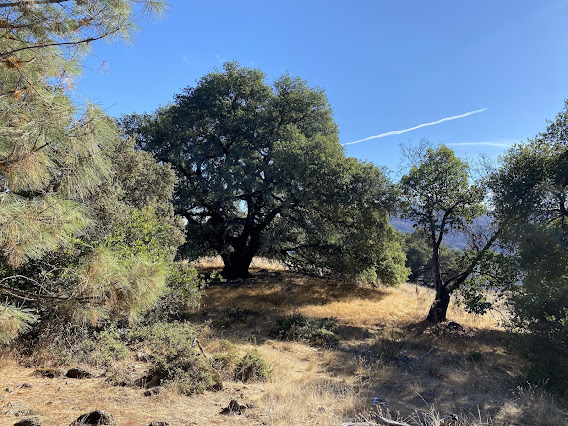Third visit
Name and Location: Lake Sonoma Wildlife Area - No Name Trail
- Time and Date: 10/21/2020; arrival 3:12pm, departure ~4:00pm
- Weather: 86 degrees F, wind S 6mph, no rain, humidity 25%, air quality 25
- Alone or with people?: With fiancé
My first observation today was that the smell is changing, it seems to be smelling sweeter. And there are so so many more flies than usual... Why is that? Is it because of the sweet smell? Maybe fermenting fruit that has fallen off the trees? It is not fruit flies though, it's the classic fly.
The oak tree that has been a big part of each of my site visits is a Coast Live Oak (Quercus Agrifolia).
There is visibly less fruit on the trees and the whole site landscape is looking dryer than the weeks prior.
It's been nice observing how week by week not much seems to change, but then when I compare my visit today to my first visit, I can see a difference in the pictures. More colorful leaves, more "debris" in the ground, the sun angle is different even though it's the same time of the day. Humidity levels have been increasing every week.
I have been wondering if the red fruit is riper than the green? It would make sense when I think about the ripening process of almost everything else. But when does it fall down? When it's dried out, red, or blackish? Also, I was curious, who, if anyone, eats this?
The drawing on top is the scatch of the picture below on the right. This rock is the habitat of moss 'Phylum Bryophyta'. Trying to draw moss is definitely the hardest thing I have ever tried when it comes to drawing.
The drawing below is of both of the pictures above and it is Toyon: Heteromeles arbutifolia

The change of season is becoming more and more obvious with the increasing amount of yellow and red leaves both on the trees and on the ground. It feels warm and cozy in that warm jacket big mug of hot tea kind of way.
I have also observed fewer needles on the evergreens. This leads me to wonder if they are still evergreens if they lose needles? Or is a certain amount of needle loss ok in the category of evergreens? Are there evergreens that lose all their needles?
I am wondering if what we see here on this Common Manzanita (Arctostaphylos Manzanita) is fire damage. It looks like coal and feels crisp.
I also checked on the 3 stage bush that I showed during my second visit, and there are no visible changes to it.











Comments
Post a Comment